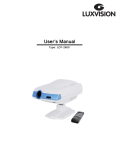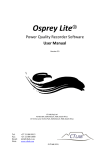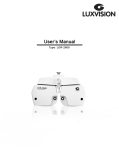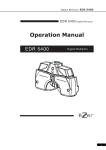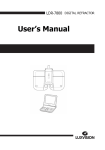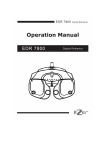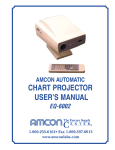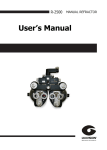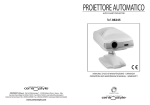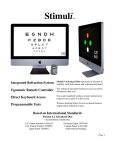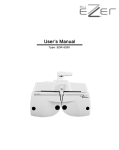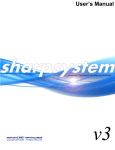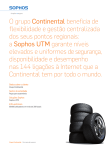Download Chart Projector ECP-5400 Ezer - US Ophthalmic
Transcript
-1- Table of Contents Introduction 3 Package Contents 4 .. 5 Classifications Designated Symbols 6 Safety Instructions 7 Instrument Components 9 Installation . ,12 Focusing ..14 Operating Instructions ..15 Charts Description ...17 Maintenance ....20 . … 24 Basic Trouble Shooting Transportation .25 Technical Specifications ..26 -2- Introduction Congratulations on your purchase of the ECP 5400 Auto Chart Projector. In the area of subjective refraction, the ECP 5400 is best used for measuring visual acuity. It is fully recommended that you carefully read, understand and follow the steps in this manual in order to ensure safe operation, optimum performance and a longer service life from your new instrument. Please retain this manual for future reference. -3- Package Contents ECP 5400 and accessories were carefully checked and packed prior to the shipment. However, please check condition and contents upon delivery. In addition to 5400, this shipment includes: 1 Metal Screen (400mm x 350mm) 1 Power Cord 1 Dust Cover 1 Remote Control 1 Pair polarized glasses 2 Spare fuses [1A, 250V] 2 AA-sized batteries -4- ECP Classifications [ Classification under the provision of 93/42/EEC(MDD)] ClassⅠ ECP 5400 is classified into ClassⅠ system. [Protection method against electric shock] ClassⅠ ECP 5400 is Classified into ClassⅠ instrument. ClassⅠ instrument in which protection against electric shock does not rely on basic insulation only, but which includes an additional safety precaution with the provision of the connection of the instrument to the protective earth conductor in fixed wiring of the installation in such a way that any accessible conductive parts cannot become live in the event of a failure of the basic insulation. [Degree of protection against ingress of liquids] IPX0 ECP 5400 is the ordinary instrument (enclosed instrument without protection against ingress of liquids). Be careful not to splash water on the instrument. [Degree of protection against flammability] ECP 5400 is classified as an equipment not suitable to be used in a Potentially flammable anesthetic mixture with air or with oxygen or nitrous oxide. Do not use near flammable materials. [Mode of operation] Continuous operation -5- Designated Symbols Symbol Description This symbol indicates a protective earth This symbol indicates that important operating and maintenance Instructions are included in this User’s Guide. This symbol on the main switch indicates that the power is OFF. This symbol on the main switch indicates that the power is ON. Manufacturer Date of Manufacturer Authorized Representative in the European community This symbol indicates a fuse. For EU Countries The following mark, the name & address of the EU Representative shows compliance of the instrument with Directive 93/42/EEC. -6- Safety Instructions At Operation - Never disassemble or touch the inside of the instrument. This may result in an electric shock or instrument malfunction. -Never yank the power cord to disconnect from wall outlet but hold the plug while disconnecting. This can weaken the metal core of the cord and may result in a short circuit or an electric shock. At Storage - Do not store the instrument in a place where it may get wet or where poisonous gas or liquid is stored. - Avoid storing the instrument in an area with excessive heat, humidity, or dust. Recommended ranges: Temperature range within -10℃ to +70℃ Relative humidity range within 30% to 85% Atmospheric pressure range within 500 to 1060hPa At Installation - Do not install the instrument near water. If water gets into the internal structure, there is the possibility of electrical Shock or instrument malfunction. -7- - Install the instrument in a stable and level place where vibration or shock does not occur. The instrument may not perform observation correctly or may malfunction. Also, if the instrument is tripped over because of any accidental shock, it may result in possible injury. After Use - If the instrument is not be used for a long time, disconnect the power cord from the wall outlet. Otherwise, it may cause a tire. - Remove batteries from the battery case of the remote controller when the remote controller will not be used for a long time. At Disposal - Follow local governing ordinances and recycling plans regarding disposal or recycling of device components. Check the specified disposing method for the specific waste in advance, especially when disposing the batteries used in the remote controller. - When disposing packing materials, sort them by the materials and follow local governing ordinances and recycling plans. -8- Instrument Components 1. Upper Case 2. Projection Lens 3. Window for remote detection 4. Table stand -9- 5. Focusing Wheel 7. Power Switch 6. Pilot Lamp 5. 8. RS-232C Connector 10. Fuse Holders -10- 9. Power Connector 11 12 18 13 19 14 15 20 16 21 17 11. Inflated ray transmitter 17. Vertical, horizontal line, single 12. Letters chart Letter Masking 13. Number chart 18. Children chart 14. Snellen chart 19. Vectograph chart 15. Program 20. Red/Green Test 16. Lamp ON/OFF 21. Direction -11- INSTALLATION The ECP 5400 should be installed according to the following procedures: 1. If using a wall mount, it is best to locate a wall stud to support the weight of instrument. 2. Determine the refracting distance (form the patient’s eye to the screen) and install the projection screen. 3. Position the instrument at the same distance from the screen to the patient within the range between 2m and 7m. To obtain longer refracting distances in small rooms, a mirror or systems of mirrors can be used. In this case, a high quality front surface mirror is required. -12- 4. Check the three-dimensional alignment of the system. The instrument is optimized when the projection screen is angled to direct light to the patient’s head. Place a mirror on the screen. patient’s head would be. -13- The light should project where the FOCUSING To obtain the correct focus: 1. Measure the distance from the patient to the screen (refracting distance). 2. Turn the Auto Chart Projector on, and using the remote control, project the 0.05 “K” onto the screen. 3. If using a wall mount, it is best to locate a wall stud to support the weight of instrument. 4. Adjust the position of the instrument forward or backward for sizing. 5. Adjust for sharpness and clarity by turning the focusing wheel left or right as needed. -14- OPERATING INSTRUCTIONS 1. Turn on the power switch of the instrument. The projection lamp lights and the chart for 0.05 vision shall be viewed in 3 seconds. 2. Changing the chart Press the appropriate chart button on the remote controller. The charts have 31 selections. 3. Isolating the visual acuity chart ■ To use Vertical line masking: Press ☞ To move the position right or left Press or ☞ To move the position up or down Press or ■ To use Horizontal line masking: Press ☞ To move the position right or left Press or ☞ To move the position up or down Press or ■ To use Single letter masking: Press ☞ To move the position right or left Press or ☞ To move the position up or down Press or ■ To use Red/Green filter: Press ■ To release masking and filter: Press any chart button -15- 4. Programmed operation ■ To install Program “A” 1) 2) Make sure press the button of “LAMP” to turn off the lamp. Keep pressing the left button to be heard buzzer sound 4 times. Then, start the mode of program A. 3) Press one of the chart buttons to memorize. 4) And then, press the right button and heard buzzer sound 1 time to memorize the selected chart. 5) Repeat the process ③, ④to memorize the selection you want. 6) Press the left button and heard buzzer sound 3 times to complete the installation of Program A. ■ To install Program “B” 1) 2) Make sure press the button of “LAMP” to turn off the lamp. Keep pressing the right button to be heard buzzer sound 4 times. Then, start the mode of program B. 3) Press one of the chart buttons to memorize. 4) And then, press the right button and heard buzzer sound 1 time to memorize the selected chart. 5) Repeat the process ③, ④to memorize the selection you want. 6) Press the left button and heard buzzer sound 3 times to complete the installation of Program B. ■ Programmed Operation 1) Turn on ECP 5400, press the button of “RESET” to select the program A or B. 2) After operate the program, change the chart by the button of ‘PROGRAM’. (Left : move to previous chart / Right : move to next chart) -16- CHARTS DESCRIPTION A-TYPE letters Duochrome Balance Cross Cylinder Dots Snellen Number Children Red / Green Astigmatism Clock Dial Worth For Dot Phoria Fixation Phoria with Fixation Schober Coincidence Cross Grid Minute Stereo Binocular Balance -17- B-TYPE letters Snellen Children Binocular Balance Duochrome Balance Cross Cylinder Dots Landolt Number Red / Green Astigmatism Clock Dial Worth For Dot Phoria with Fixation Fixation Coincidence Schober Minute Stereo Cross Grid -18- C-TYPE letters Horizontal Line Red / Green Cross Cylinder Dots Worth For Dot Astigmatism Clock Dial Fixation Phoria Schober Phoria with Fixation Cross Grid Coincidence Vertical Children Binocular Balance Minute Stereo Children Vertical Line Snellen Number -19- MAINTENANCE Risk of electric shock. Always disconnect the power cord from the wall and the instrument prior to performing any of the following procedures. ■ Maintenance There is no periodic or routine user maintenance required. ■ Cleaning There are no cleaning requirements other than regular office housekeeping, such as dusting. ☞ Cleaning the main body < Projection Lens > 1) Blow dusts with a blower brush. 2) If it is not clean enough, wipe with lens cleaning paper. < Cover and Screen > 1) Wipe with a dry and soft cloth. 2) If for some reason the instrument becomes soiled, wipe it with the damp lint-free cloth and mild detergent. Then, wipe off with a dry cloth to finish. ■ Disassembling the upper case 1) Turn off the power and pull out the power cord. 2) Unfasten the screw in counterclockwise at the back side of case 3) Disassemble the Upper Case by lifting it. 4) In case of reassembling, place the Upper case on the main body and adjust t he front position. Then, fasten the screw in clockwise. -20- ■ Replacement of lamp The lamp may be HOT! Do not touch the Lamp directly and allow the sufficient amount of time to cool down the heat. 1) Unfasten the screw at the Lamp Cover. 2) Disassemble the Lamp Cover by lifting it and pull out the Lamp. 3) Place the new Lamp at the hole of Lamp Holder. 4) Turn on the power switch. 5) Place the white paper in front of the projection lens in order to project the filament image of lamp. -21- 6) Adjust the filament image at the center of paper with the screw at the lamp plate. (Note : Do not look into the lamp directly) 7) Place the Lamp Cover and fasten the screw. 8) Turn off the power switch. ■ Replacement of Fuses 1) Turn off the power switch and disconnect the power cord. -22- 2) Push and turn the fuse holder a quarter counterclockwise with your finger and remove it. 3) Pull out the fuse from the fuse holder and check the condition. 4) Replace the fuse with the provided spare or equivalent as specified below. VOLTAGE FUSE 100V ~ 240V 1A 250V ; T1AL 5) Simply return it with the fuse holder to the socket. Push and turn it a quarter clockwise to lock. -23- Basic Trouble Shooting Note: Risk of electric shock. Always disconnect the power cord from the wall and the instrument prior to performing any of the following procedures. ■ If the instrument does not function at all: 1) Check the facility power source. (Circuit Breakers) 2) Check the electrical connections. (Power Cord) 3) Check the main fuse located on the rear of the unit. ■ If the projector lamp does not light: 1) Check the main On/Off Switch. 2) Replace the lamp with the spare lamp. The lamp may be HOT! Do not touch the Lamp directly sufficient amount of time to cool down the heat. ■ If the projector turns on but does not function: 1) Check the batteries in the remote control. -24- and allow the Transportation ■ Make sure the instrument is disconnected from the power source. ■ If the instrument was installed on a custom mount, please remove the unit from the mount. ■ Pack the instrument in a sturdy carton with suitable packing materials. ■ After packing, do not hurl and impact cause of breakable goods. - Do not use this machine near by other machines or electric bulb (ex. Halogen lamp), it will improperly operate on the effect of electronic waves. -25- Technical Specifications Chart Chart selection speed Mask 31 Selections Average 0.3 sec. 1 open 3 horizontal lines 3 vertical lines Filter 21 single letters Red/Green Projection distance 2.0m~7.0m (3m is standard) Projection magnification 30 x (at 5m) Projection size φ252mm and 330mm(W) x 225mm(H) (at 5m) Tilt angle Ball joint (±10 degree) Lamp 6V 20W(Halogen) Power source AC 100~240V 50/60Hz Power consumption 80VA Auto-Off function 5~10minutes after Dimensions Net weight Main body : 265(H) x 230(W) x 360(D)mm Remote controller : 20(H) x 64(W) x 195(D)mm Main body : 6.0Kg Remote controller : 180g 1 dust cover 1 metal screen (400mm x 350mm), Accessories 1 Pair of polarizing spectacles 2 spare fuses 2 batteries (AA-sized) wall bracket Optional accessories floor stand red/green glasses 8-pin connector for simultaneous control Interface of chart, mask and R/G filter by a motorized refractor's control unit. -26- -27-



























